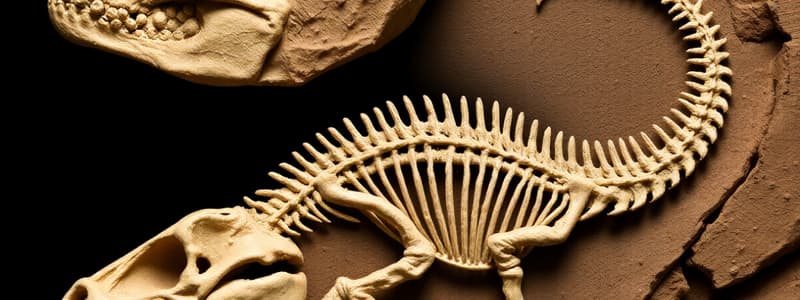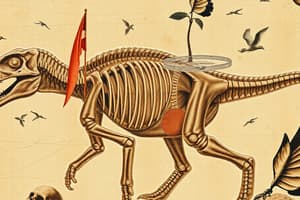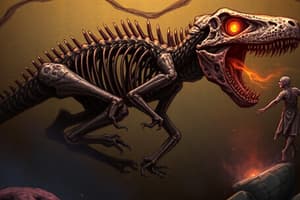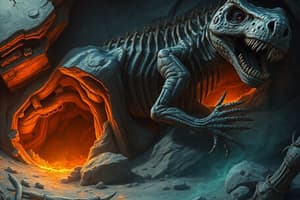Podcast
Questions and Answers
Which of the following scenarios best exemplifies the principles of taphonomy?
Which of the following scenarios best exemplifies the principles of taphonomy?
- A paleontologist analyzes the carbon isotope ratios in a fossilized leaf to determine the atmospheric conditions during the plant's life.
- An archaeologist excavates a human burial site and documents the position and condition of the skeletal remains. (correct)
- A researcher studies the arrangement of brachiopod shells in a sedimentary rock layer to infer ancient current directions.
- A geologist examines the microscopic structures of fossilized bacteria to understand the origin of life on Earth.
In the hierarchical classification system, which level of classification would contain a greater diversity of organisms than the 'Order' level?
In the hierarchical classification system, which level of classification would contain a greater diversity of organisms than the 'Order' level?
- Species
- Class (correct)
- Genus
- Family
A fossil found in sedimentary rock shows the distinct outline of a leaf, but the original organic material has been replaced by minerals. Which mode of fossil preservation is most likely represented by this specimen?
A fossil found in sedimentary rock shows the distinct outline of a leaf, but the original organic material has been replaced by minerals. Which mode of fossil preservation is most likely represented by this specimen?
- Unaltered hard parts
- Unaltered soft parts
- Altered soft parts
- Altered hard parts (correct)
Which of the following fossil types would likely provide the least amount of information about the original organism's anatomy or behavior?
Which of the following fossil types would likely provide the least amount of information about the original organism's anatomy or behavior?
Researchers discover a new fossil site containing a variety of trace fossils, including burrows and trackways, but no body fossils. What type of information can these trace fossils provide about the ancient environment?
Researchers discover a new fossil site containing a variety of trace fossils, including burrows and trackways, but no body fossils. What type of information can these trace fossils provide about the ancient environment?
Which mineral replacement is most indicative of anoxic environmental conditions during fossilization?
Which mineral replacement is most indicative of anoxic environmental conditions during fossilization?
A paleontologist discovers a fossil of a mollusk shell where the original aragonite has dissolved, leaving a void later filled with calcite. What type of fossil is this an example of?
A paleontologist discovers a fossil of a mollusk shell where the original aragonite has dissolved, leaving a void later filled with calcite. What type of fossil is this an example of?
Which type of fossil mold preserves both internal and external features of the original organism?
Which type of fossil mold preserves both internal and external features of the original organism?
What environmental conditions are most conducive to the formation of stromatolites?
What environmental conditions are most conducive to the formation of stromatolites?
Which feature distinguishes thrombolites from stromatolites?
Which feature distinguishes thrombolites from stromatolites?
A paleontologist discovers a fossilized burrow system in ancient sediment. What type of biogenic structure is this considered?
A paleontologist discovers a fossilized burrow system in ancient sediment. What type of biogenic structure is this considered?
In a replacement fossil where the original material is replaced by silica (opal), what does this indicate about the conditions during fossilization?
In a replacement fossil where the original material is replaced by silica (opal), what does this indicate about the conditions during fossilization?
What is a key difference between a 'mold' and a 'replica' fossil when examining external features?
What is a key difference between a 'mold' and a 'replica' fossil when examining external features?
Which geological condition is LEAST conducive to the preservation of unaltered soft parts of organisms?
Which geological condition is LEAST conducive to the preservation of unaltered soft parts of organisms?
A paleontologist discovers a fossilized mollusk shell where the aragonite has been replaced by calcite. What type of alteration has occurred?
A paleontologist discovers a fossilized mollusk shell where the aragonite has been replaced by calcite. What type of alteration has occurred?
In the context of fossil preservation, what is the primary role of 'Obrution'?
In the context of fossil preservation, what is the primary role of 'Obrution'?
Which of the following fossil types would MOST likely retain its original mineral composition?
Which of the following fossil types would MOST likely retain its original mineral composition?
A fossil is found with its internal pores filled with minerals that precipitated from surrounding fluids. Which preservation process does this exemplify?
A fossil is found with its internal pores filled with minerals that precipitated from surrounding fluids. Which preservation process does this exemplify?
Which of the following scenarios would be MOST likely to result in the formation of coal?
Which of the following scenarios would be MOST likely to result in the formation of coal?
A scientist is studying a Lagerstättten deposit. What unique characteristic would they expect to find in these deposits compared to typical fossil sites?
A scientist is studying a Lagerstättten deposit. What unique characteristic would they expect to find in these deposits compared to typical fossil sites?
Which mineral is commonly associated with the preservation of vertebrate bones?
Which mineral is commonly associated with the preservation of vertebrate bones?
Which characteristic is unique to Hyaline foraminifera tests?
Which characteristic is unique to Hyaline foraminifera tests?
What is the primary advantage for foraminifera in engaging in endosymbiosis with photosynthetic organisms?
What is the primary advantage for foraminifera in engaging in endosymbiosis with photosynthetic organisms?
Which group represents the earliest known foraminifera, based on fossil record evidence?
Which group represents the earliest known foraminifera, based on fossil record evidence?
Which foraminifera suborder, characterized by their agglutinated tests, first appeared during the Cambrian period and continues to exist today?
Which foraminifera suborder, characterized by their agglutinated tests, first appeared during the Cambrian period and continues to exist today?
During which geological period did the Fusulinina, known for their large size and spindle shape, thrive in shallow, illuminated waters?
During which geological period did the Fusulinina, known for their large size and spindle shape, thrive in shallow, illuminated waters?
What key feature characterizes foraminifera belonging to the Miliolina suborder?
What key feature characterizes foraminifera belonging to the Miliolina suborder?
Nummulites, belonging to the Rotaliina suborder, were instrumental in the early development of biostratigraphy. What geological feature did their presence help correlate?
Nummulites, belonging to the Rotaliina suborder, were instrumental in the early development of biostratigraphy. What geological feature did their presence help correlate?
In what specific way do symbionts assist large foraminifera, besides providing energy through photosynthesis?
In what specific way do symbionts assist large foraminifera, besides providing energy through photosynthesis?
Which evolutionary adaptation is characteristic of the Globigerinida suborder, allowing them to thrive in oceanic environments?
Which evolutionary adaptation is characteristic of the Globigerinida suborder, allowing them to thrive in oceanic environments?
How do agglutinated foraminifera tests differ compositionally from those of porcelaneous foraminifera?
How do agglutinated foraminifera tests differ compositionally from those of porcelaneous foraminifera?
Which of the following best describes the process of 'reorientation' in biostratinomy?
Which of the following best describes the process of 'reorientation' in biostratinomy?
What would a bimodal orientation of shell apices, where the apices point in two directions approximately 180 degrees apart, indicate about the depositional environment?
What would a bimodal orientation of shell apices, where the apices point in two directions approximately 180 degrees apart, indicate about the depositional environment?
Fossils found in sediments that are described as 'exotic' are fossils that:
Fossils found in sediments that are described as 'exotic' are fossils that:
How does grain size primarily influence the distribution and abundance of epifauna and infauna in a marine environment?
How does grain size primarily influence the distribution and abundance of epifauna and infauna in a marine environment?
In the context of substrate consistency, a 'firmground' environment is characterized by:
In the context of substrate consistency, a 'firmground' environment is characterized by:
How does increased turbulence in a shallow marine environment typically affect filter-feeding organisms?
How does increased turbulence in a shallow marine environment typically affect filter-feeding organisms?
What is the primary effect of increased turbidity on deposit feeders in an aquatic ecosystem?
What is the primary effect of increased turbidity on deposit feeders in an aquatic ecosystem?
Which metabolic factor most directly influences the distribution of photosynthetic organisms in marine environments?
Which metabolic factor most directly influences the distribution of photosynthetic organisms in marine environments?
How does the siphuncle contribute to the survival of cephalopods with shells?
How does the siphuncle contribute to the survival of cephalopods with shells?
What is the function and composition of the nacreous layer in a molluscan shell?
What is the function and composition of the nacreous layer in a molluscan shell?
What is the primary functional difference between lobes and saddles in the suture patterns of ammonoid cephalopods?
What is the primary functional difference between lobes and saddles in the suture patterns of ammonoid cephalopods?
The presence of complex suture patterns in ammonoid cephalopods is believed to have primarily served what purpose?
The presence of complex suture patterns in ammonoid cephalopods is believed to have primarily served what purpose?
Which of the following cephalopod subclasses is characterized by a simple, nautiloid-like suture and is considered ancestral to both the Ammonoidea and Coleoidea?
Which of the following cephalopod subclasses is characterized by a simple, nautiloid-like suture and is considered ancestral to both the Ammonoidea and Coleoidea?
Which characteristic of ammonoid cephalopods makes them particularly useful for biostratigraphy?
Which characteristic of ammonoid cephalopods makes them particularly useful for biostratigraphy?
Besides ammonites, which other cephalopod groups contribute significantly to biostratigraphy and in what geological periods are they most useful?
Besides ammonites, which other cephalopod groups contribute significantly to biostratigraphy and in what geological periods are they most useful?
Which characteristic of foraminifera is most helpful when using them as markers for dating short time periods?
Which characteristic of foraminifera is most helpful when using them as markers for dating short time periods?
During which geological period did predators first move into the water column, marking a significant shift in marine ecosystems?
During which geological period did predators first move into the water column, marking a significant shift in marine ecosystems?
What evolutionary problem did chambered shells present for early cephalopods, requiring them to develop various balancing mechanisms?
What evolutionary problem did chambered shells present for early cephalopods, requiring them to develop various balancing mechanisms?
How did the evolution of tighter coiling (involute) in cephalopod shells primarily improve their adaptation to marine environments?
How did the evolution of tighter coiling (involute) in cephalopod shells primarily improve their adaptation to marine environments?
Which of the following is an example of an adaptation that helped early cephalopods maintain buoyancy?
Which of the following is an example of an adaptation that helped early cephalopods maintain buoyancy?
According to the shape parameter formulas, what does a whorl expansion rate (W) close to 1 indicate about the cephalopod's shell?
According to the shape parameter formulas, what does a whorl expansion rate (W) close to 1 indicate about the cephalopod's shell?
How does a smaller aperture distance (D) from the axis affect the coiling of a cephalopod shell, and what advantage does this provide?
How does a smaller aperture distance (D) from the axis affect the coiling of a cephalopod shell, and what advantage does this provide?
What environmental factor primarily limits the distribution and diversity of planktonic foraminifera in marine environments?
What environmental factor primarily limits the distribution and diversity of planktonic foraminifera in marine environments?
What is a distinctive characteristic of benthic foraminifera that differentiates them from planktonic foraminifera?
What is a distinctive characteristic of benthic foraminifera that differentiates them from planktonic foraminifera?
What adaptation is commonly found in planktonic foraminifera to counteract sinking in the water column?
What adaptation is commonly found in planktonic foraminifera to counteract sinking in the water column?
Flashcards
Hierarchical Classification
Hierarchical Classification
A system for classifying living things from broad (Domain) to specific (Species).
Taphonomy
Taphonomy
The study of the processes affecting an organism after death, leading to fossilization.
Paleoecology
Paleoecology
The study of interactions between fossilized organisms and their environment.
Fossil
Fossil
Signup and view all the flashcards
Mineral Replacements
Mineral Replacements
Signup and view all the flashcards
Unaltered Soft Parts
Unaltered Soft Parts
Signup and view all the flashcards
Mummification
Mummification
Signup and view all the flashcards
Altered Soft Parts
Altered Soft Parts
Signup and view all the flashcards
Anoxia
Anoxia
Signup and view all the flashcards
Obrution
Obrution
Signup and view all the flashcards
Fossil Lagerstätten
Fossil Lagerstätten
Signup and view all the flashcards
Unaltered Hard Parts
Unaltered Hard Parts
Signup and view all the flashcards
Recrystallization
Recrystallization
Signup and view all the flashcards
Silicified Wood/Permineralization
Silicified Wood/Permineralization
Signup and view all the flashcards
Leached Fossil
Leached Fossil
Signup and view all the flashcards
Steinkern (Core)
Steinkern (Core)
Signup and view all the flashcards
Cast Fossil
Cast Fossil
Signup and view all the flashcards
Replica Fossil
Replica Fossil
Signup and view all the flashcards
Mold Fossil
Mold Fossil
Signup and view all the flashcards
Stromatolites
Stromatolites
Signup and view all the flashcards
Thrombolites
Thrombolites
Signup and view all the flashcards
Ideal Fossil Markers
Ideal Fossil Markers
Signup and view all the flashcards
Pelagic Realm Predators
Pelagic Realm Predators
Signup and view all the flashcards
Endocones
Endocones
Signup and view all the flashcards
Beaded Calcified Siphuncle
Beaded Calcified Siphuncle
Signup and view all the flashcards
Cameral Deposits
Cameral Deposits
Signup and view all the flashcards
Ascocones
Ascocones
Signup and view all the flashcards
Brevicone
Brevicone
Signup and view all the flashcards
Involute Coiling
Involute Coiling
Signup and view all the flashcards
Evolute Coiling
Evolute Coiling
Signup and view all the flashcards
Planktonic Foraminifera
Planktonic Foraminifera
Signup and view all the flashcards
Dinoflagellates
Dinoflagellates
Signup and view all the flashcards
Diatoms
Diatoms
Signup and view all the flashcards
Benefits of Endosymbionts
Benefits of Endosymbionts
Signup and view all the flashcards
Foraminifera Shell Wall Types
Foraminifera Shell Wall Types
Signup and view all the flashcards
Allogromiida
Allogromiida
Signup and view all the flashcards
Textulariida
Textulariida
Signup and view all the flashcards
Fusulinia
Fusulinia
Signup and view all the flashcards
Globigerinida
Globigerinida
Signup and view all the flashcards
Miliolina
Miliolina
Signup and view all the flashcards
Rotaliina
Rotaliina
Signup and view all the flashcards
Coprolites
Coprolites
Signup and view all the flashcards
Biomarkers
Biomarkers
Signup and view all the flashcards
Biostratinomy
Biostratinomy
Signup and view all the flashcards
Disarticulation
Disarticulation
Signup and view all the flashcards
Abrasion
Abrasion
Signup and view all the flashcards
Reorientation
Reorientation
Signup and view all the flashcards
Dissolution
Dissolution
Signup and view all the flashcards
Indigenous Fossils
Indigenous Fossils
Signup and view all the flashcards
Exotic Fossils
Exotic Fossils
Signup and view all the flashcards
Reworked Fossils
Reworked Fossils
Signup and view all the flashcards
Limiting Factors
Limiting Factors
Signup and view all the flashcards
Epifauna
Epifauna
Signup and view all the flashcards
Infauna
Infauna
Signup and view all the flashcards
Siphuncle
Siphuncle
Signup and view all the flashcards
Suture
Suture
Signup and view all the flashcards
Study Notes
Hierarchical Classification of Life
- The order from most general to most specific is: Domain, Kingdom, Phylum, Subphylum, Class, Order, Family.
- A common mnemonic is: King Phillip Came Over For Good Soup.
Taphonomy- fossil preservation
- Taphonomy refers to the changes an organism undergoes from death to discovery as a fossil.
- It controls the fidelity of the fossil record and provides important environmental information.
- Paleoecology studies fossilized organisms including their life, and their environment as fossils..
Fossils
- Fossils are any object that provides evidence of prehistoric life.
- Fossils can be physical remains like shells, bones, and hardparts.
- Fossils can be mineral replacements where bodies/skeletons are replaced by minerals.
- Fossils can be biological impressions include tracks, trails, burrows, or chemical signatures like biomarkers, indicating life.
Modes of Fossil Preservation
- The modes of fossil preservation from least to most information loss are:
- Unaltered soft parts
- Altered soft parts
- Unaltered hard parts
- Altered hard parts
- Leached fossils
- Biogenic structures
- biomarkers
Soft Part Preservation
- Unaltered soft parts experience no change to organic tissues except for water loss.
- Preservation methods are freezing, mummification (dehydration/desiccation), and conservation traps.
- Altered soft parts involve carbonization or mineralization of organic tissues.
- Anoxia, or oxygen depletion, and obrution, or rapid burial, are important.
- Fossil Lagerstätten are “motherlodes” of fossils with great preservation of soft tissues and articulated hard parts.
- Examples of this occur through the Phanerozoic.
Hard Part Preservation
- Unaltered hard parts: original mineral composition remains intact.
- Various minerals are associated with certain organisms.
- Calcite (LMC): Brachiopods, bryozoans, paleozoic corals, echinoderms.
- Aragonite: Molluscs, modern corals.
- Silica: Radiolaria, diatoms, some sponges.
- Phosphate: Vertebrate bones, conodonts, inarticulate brachiopods.
- chitin/collagen: Arthropods, grapolites.
- cellulose: Wood, plant material.
- Altered hard parts can undergo recrystallization, where there is a change in crystal structure but no change in chemical composition.
- Recrystallization can be accompanied by loss of water in the mineral with aragonite (CaCO3) converting to LMC (CaCO3) and silica changing to quartz (with water loss)
- Any mineral (fine crystals → coarse crystals) can be altered, but only heat and pressure remove volatile elements during Carbonization leaving a carbon film,
- What is left includes resistant and stable parts of molecule such as in coal (black) or graphite (silver).
- Permineralization (Petrification) occurs when pores of the skeleton infilled with minerals that precipitate out of fluids thereby turning something into stone that won’t burn.
- Fossil wood and Permineralized dinosaur bones are examples of this.
- Replacement occurs when the original skeleton dissolves while precipitating a new mineral through common minerals like dolomite, silica, pyrite, or limonite/goethite.
- Leached Fossils: Original shell dissolves, leaving a void or filling with minerals.
- Common in molluscs because Aragonite dissolves easily.
Fossil Molds
- There are different types of fossil molds.
- Steinkern (core) has only internal features such as muscle attachments. It the most common type, pops out in 3D.
- Casts have internal and external features (full replica 3D)
- Replica show external features only, and are 3D.
- Molds show external features only, preserves shell structure and is 2D.
Biogenic Structures
- Biostratification is when the orientation of plant or animal remains are used to determine relative ages of rock strata.
- Stromatolites are a fossilized bacterial structure built by cyanobacteria in environments where grazers are excluded, with high salinity, high water temperature and strong currents.
- Abundant before grazing animals evolved (Precambrian).
- Bacteria cover the sediment surface trapping carbonate mud and/or precipitates to build low domes where High areas grow faster than low areas.
- Reliably increases upward to form stromatolite.
- Thrombolites: unlaminated, clotted microbial build ups.
-
- Trace fossils are tracks, trails, burrows, and borings.
-
- Coprolites are fossilized animal excrement.
Biomarkers
- Biomarkers are chemical evidence of life.
- Diagenesis, hopanepolyol (organic compound from the cell walls of bacteria), hopane (organic compound derived from hopanepolyol), and cholesterol (indicate animal kingdom).
Biostratinomy
- Biostratinomy occurs from death to final burial, where biological information may be lost, but information from the depositional environment can be gained.
- Processes involved are disarticulation (the removal of joints): complete arthropods and echinoderms can only be preserved through obrution (burying)
- Progressive crinoid disintegration due to scavenging, complete calyces and stems, partial stems and disarticulate columnals, and disarticulated columnals
- Abrasion is wear from transport that result in Fossil hash.
- Bivalves hold up stronger and are measured using Mohs Harness Scales
Transport of Shells
- Transport of shells via traction currents (bedload) = extensive abrasion.
- Transport of shells in suspension = minimal abrasion.
- Example: Storm beds, turbidites (current flow with higher density)
- Reorientation is when currents/waves align shells.
- Unimodal Orientation: all apices point in the same direction if there is current flowing in one direction, but you can't identify the direction.
- Bimodal Orientation: apices pointing in two directions (180 apart) points to an Oscillating current.
Shell orientation
- During shell orientation Shells flip after a threshold.
- Concave-down orientation = wave or current activity when current threshold flipped them over if no preferred horizontal orientation when waves/currents were strong enough to flip the shells, but too weak to orient them, however Strong bimodal orientation if there were strong wave action
Transportation
- Dissolution occurs when shells dissolve in cold/freshwater and can also occur prior to burial.
- Transportation: occurs through several ways
- Indigenous materials are found in the same environment they lived in shuffled in order but close, and are used in paleoecology and biostratigraphy
- Exotic materials are transported from a different (but same time) environment, mixing diff communities is deposited by storms, used in biostratigraphy only
- Reworked (remanie) materials are fossils from older rocks mixed with new sediments can mislead age dating.
Paleoecology
- Paleoecology: evolution of ecosystems.
- Considers Environmental changes (big and small) and helps understands ecosystem evolution and limiting factors.
- Used to:Explain how modern ecosystems respond to climate change; Show how ecosystems become complex over time; Understand Limiting factors that control species presence and abundance.
- Limiting Factor Categories include sedimentologic, metabolic and combination.
- Sedimentologic: grain size; substrate consistency (how cohesive the grains are is the most important factor affecting benthic organics); turbulence (water agitation) that favours filter-feeders in shallow environments, but is harmful to fragile/branching organisms; turbidity (suspended sediment) that is harmful to filter-feeders and clogs respiratory/feeding systems.
- Metabolic: light that affects photosynthesis and vision, sunlight diminishes in quantity and wavelength spectrum with depth influences distribution of organisms; salinity where freshwater and euryhaline environments have the most diverse life -shelly animals are diverse in freshwater and normal marine environments but are approaching a limiting factor.
- Decrease in oxygen affects shelly fossils (affect ability to respire/metabolize).
- Light zones influence what can be seen regarding photosythesis and vision and oxygen abundance
- Grain size: influences type and abundance of organisms; epifauna (surface) sand which makes it mobile (moves with waves); mud and gravel make it less mobile (easier to attach).
Substrate Consistency
- Most important factor affecting benthic organics.
- Considers Category which can be: -Hardground (rock/shell)
- Firmground (stiff mud)
- Softground (loose sediment)
- Superground (soupy mud)
- It is easiest for sand burrowing but hardest for burrowing in gravel.
Oxygen Levels
- Oxic (>1 ml/L): abundant fossils, predators coomon.
- Disoxic (0.1-.1ml/L): few fossils, burrows (soft-bodied animals) only, predators are rare (require lots of E), few shelly fossils (affect ability to respire/metabolize) ;
- Anoxic (<0.1ml/L) and decreases as oxygen decreases
- Light zones affects photosynthesis, vision and animal/plant life
Ecological concepts:
- Individual – single organisms.
- Population - group of same species area/time.
- Community: all Populations areatime.
- Ecosystem- interaction living and nonliving.
- Trophic chains and webs:
- Trophic chain: energy and matter flow from one organism to another ex chemoautorophs get E from breaking down organic matter or organisms beginning.
- Trophic levels :organism that same # of steps of E & matter.
Marine Paleoecology
Categories:
- Pelagic- live in the water column, Neustonic Surface floater , Planktonic floaters, Nektonic swimmers.
- Benthic -Live on/in bottom.
- Bumbach-Bush ecospace Cube:
- Motility, Feeding type, Relative location to sea floor, tiering, 216 categories total
Paleoecology - Features in Marine settings
- Limiting Factors, fossil record , ecosystem completion, and Herbivory
- Trace fossils- Preserved behavior of organism in lock/ sediment - ichno=footprint
History of Ichology - trace fossils classified based on behavior
- Originators- can be identified through trace fossil formation through different types of traces
Universal ichnofacies: -
- Ichnofacies are classified as
- Two Main types, substrate controlled, depth controlled
Studying That Suits You
Use AI to generate personalized quizzes and flashcards to suit your learning preferences.




